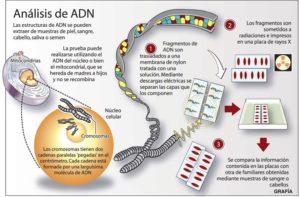When are DNA tests performed?
DNA testing, as it is commonly called, is used for human identification. DNA, which is the molecule responsible for heredity, is unique to each person and is found in every cell in the body. Through its study it is possible to identify a person from very small biological clues, invisible to the human eye.
For this reason, it is useful to establish affiliations and other family relationships, for example paternity, maternity, biological relationship between grandparents-grandchildren, half-siblings, uncles-nephews, etc., explains bioanalyst Aníbal Gaviria, specialist in Forensic Sciences and director of the molecular genetics laboratory of the Ecuadorian Red Cross.
In this laboratory, the minimum probability of paternity in a result is 99.99%.
On the other hand, Dr. Galo Monroy, immunologist and head of the area of genetics and molecular diagnosis of the Immunolab clinical laboratory, details that this type of study is also used to diagnose diseases. "In our laboratory, most of the cases that are requested are for paternity tests," he says.
Advertising

However, biological link tests with other relatives are also requested, but less frequently, he comments. In other cases and in specialized laboratories for the crime area, forensic evidence is the most requested.
Procedures
Regarding the technical-scientific procedure of DNA testing, there are several procedures, as well as numerous markers and genes that can be studied. However, most labs offer two options, Monroy says.
The first is the taking of a blood sample by means of a venipuncture and the second is the taking of a sample of buccal cells by means of a swab. To do this, a sterile swab (Q-tip) is used, preferably made of a special material for this purpose and rubbed several times against the cheek inside the mouth.
Both sampling methods contain genetic material of good quantity and quality. However, the laboratory will indicate certain observations such as, for example, in cases of babies who are breastfed, they must not have breastfed in the last two hours prior to the sampling; because their mouth may contain cells from the mother and make it difficult to obtain a genetic profile of the baby.
Similarly, a person who has recently received a blood transfusion or bone marrow transplant may contain donor cells and not their own cells in their blood circulation. "In these cases we recommend notifying the laboratory," suggests Monroy.
Dr. Gaviria finally details that the study of the samples is carried out using the PCR technique (Polymerase Chain Reaction) and at least 20 genetic markers called STRs are amplified, which are highly variable and provide the genetic profile individually for each patient.
The profiles are compared and the results can establish the Exclusion of the relationship or its Non-exclusion. "In the latter case, the result is reported in terms of probability of relationship with a percentage equal to or greater than 99.99% and a relationship index."







